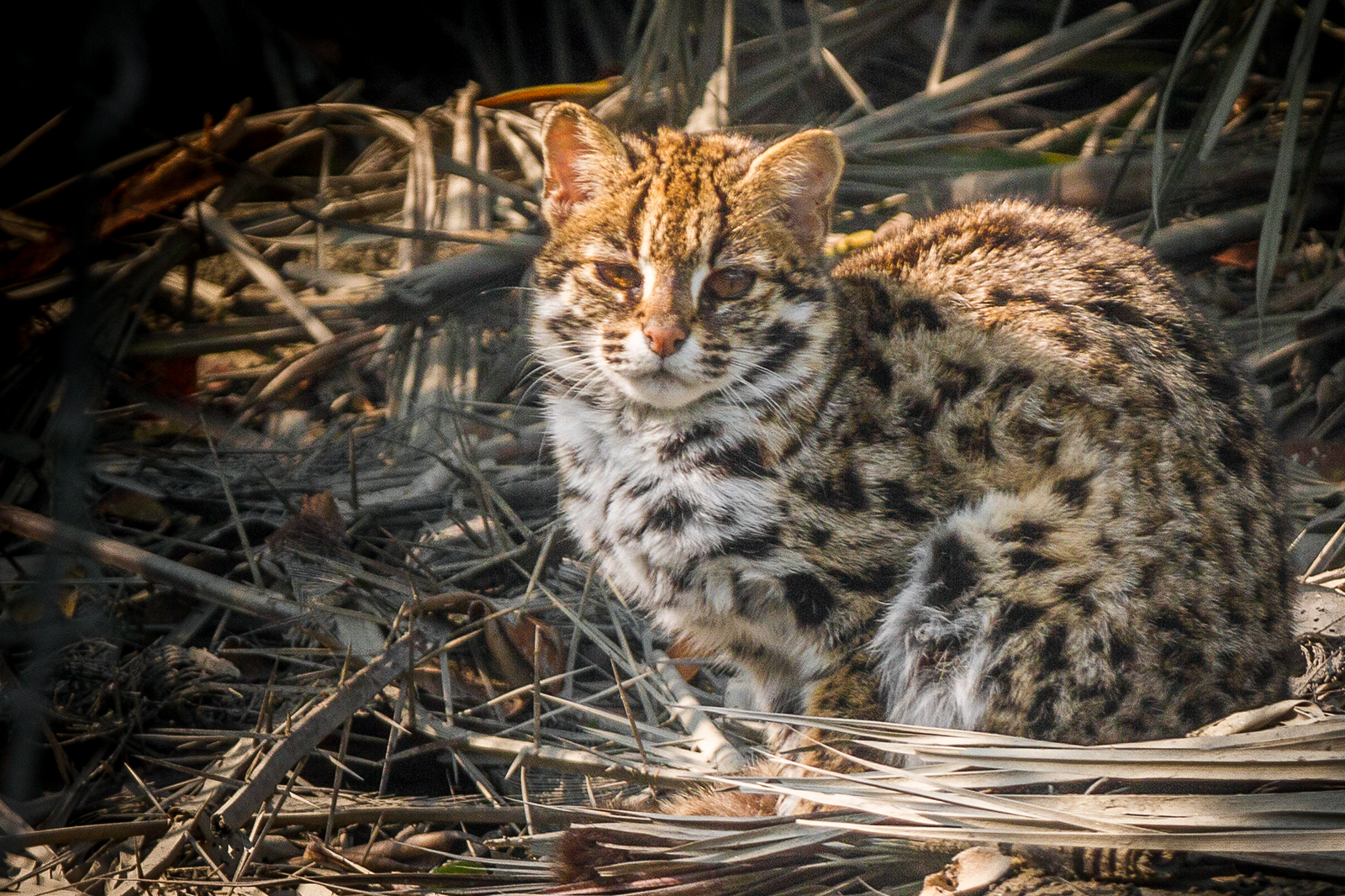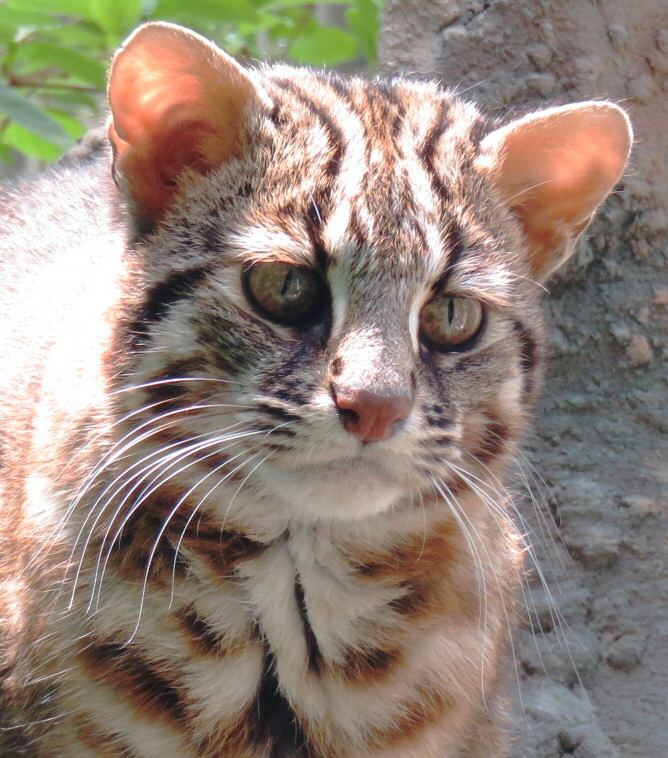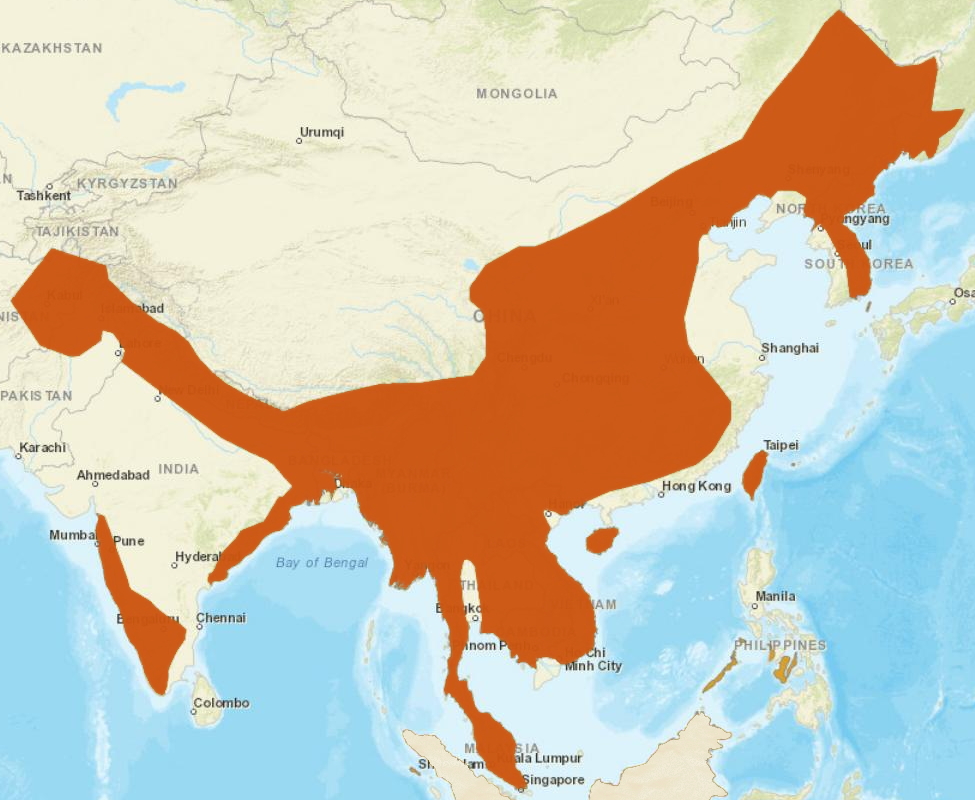|
Prionailurus
''Prionailurus'' is a genus of spotted, small wild cats native to Asia. Forests are their preferred habitat; they feed on small mammals, reptiles and birds, and occasionally aquatic wildlife. Taxonomy ''Prionailurus'' was first proposed by the Russian explorer and naturalist Nikolai Severtzov in 1858 as a generic name for a single felid occurring in tropical Asia, namely ''Felis pardachrous'' described by Brian Houghton Hodgson — the leopard cat. As varieties, Severtzov lists ''Felis nipalensis'' described by Thomas Horsfield and Nicholas Aylward Vigors, ''Leopardus Elliotti'', ''Leopardus Horsfieldi'' and ''Leopardus chinensis'' described by John Edward Gray, and ''Felis bengalensis'' described by Anselme Gaëtan Desmarest. The British zoologist Reginald Innes Pocock recognized the taxonomic classification of ''Prionailurus'' in 1917. In 1939, he described the genus on the basis of skins and skulls, and compared these to body parts of ''Felis''. ''Prionailurus'' species ... [...More Info...] [...Related Items...] OR: [Wikipedia] [Google] [Baidu] |
Fishing Cat
The fishing cat (''Prionailurus viverrinus'') is a medium-sized wild cat of South and Southeast Asia. Since 2016, it is listed as Vulnerable on the IUCN Red List. Fishing cat populations are threatened by destruction of wetlands and have declined severely over the last decade. The fishing cat lives foremost in the vicinity of wetlands, along rivers, streams, oxbow lakes, in swamps, and mangroves. The fishing cat is the state animal of West Bengal. Taxonomy ''Felis viverrinus'' was proposed by Edward Turner Bennett in 1833 who described a fishing cat skin from India. '' Prionailurus'' was proposed by Nikolai Severtzov in 1858 as generic name for spotted wild cats native to Asia. ''Felis viverrinus rhizophoreus'' was proposed by Henri Jacob Victor Sody in 1936 who described a specimen from the north coast of West Java that had a slightly shorter skull than fishing cat specimens from Thailand. There is evidence that the nominate taxon and the Javan fishing cat are distinguish ... [...More Info...] [...Related Items...] OR: [Wikipedia] [Google] [Baidu] |
Leopard Cat
The leopard cat (''Prionailurus bengalensis'') is a small wild cat native to continental South, Southeast, and East Asia. Since 2002 it has been listed as Least Concern on the IUCN Red List as it is widely distributed although threatened by habitat loss and hunting in parts of its range. Historically, the leopard cat of continental Asia was considered the same species as the Sunda leopard cat. As of 2017, the latter is recognised as a distinct species, with the taxonomic name ''Prionailurus javanensis''. Leopard cat subspecies differ widely in fur colour, tail length, skull shape and size of carnassials. Archaeological evidence indicates that the leopard cat was the first cat species domesticated in Neolithic China about 5,000 years ago in Shaanxi and Henan Provinces. Characteristics A leopard cat is about the size of a domestic cat, but more slender, with longer legs and well-defined webs between its toes. Its small head is marked with two prominent dark stripes and a s ... [...More Info...] [...Related Items...] OR: [Wikipedia] [Google] [Baidu] |
Leopard Cat
The leopard cat (''Prionailurus bengalensis'') is a small wild cat native to continental South, Southeast, and East Asia. Since 2002 it has been listed as Least Concern on the IUCN Red List as it is widely distributed although threatened by habitat loss and hunting in parts of its range. Historically, the leopard cat of continental Asia was considered the same species as the Sunda leopard cat. As of 2017, the latter is recognised as a distinct species, with the taxonomic name ''Prionailurus javanensis''. Leopard cat subspecies differ widely in fur colour, tail length, skull shape and size of carnassials. Archaeological evidence indicates that the leopard cat was the first cat species domesticated in Neolithic China about 5,000 years ago in Shaanxi and Henan Provinces. Characteristics A leopard cat is about the size of a domestic cat, but more slender, with longer legs and well-defined webs between its toes. Its small head is marked with two prominent dark stripes and a s ... [...More Info...] [...Related Items...] OR: [Wikipedia] [Google] [Baidu] |
Prionailurus Bengalensis In Indonesia 02
''Prionailurus'' is a genus of spotted, small wild cats native to Asia. Forests are their preferred habitat; they feed on small mammals, reptiles and birds, and occasionally aquatic wildlife. Taxonomy ''Prionailurus'' was first proposed by the Russian explorer and naturalist Nikolai Severtzov in 1858 as a generic name for a single felid occurring in tropical Asia, namely ''Felis pardachrous'' described by Brian Houghton Hodgson — the leopard cat. As varieties, Severtzov lists ''Felis nipalensis'' described by Thomas Horsfield and Nicholas Aylward Vigors, ''Leopardus Elliotti'', ''Leopardus Horsfieldi'' and ''Leopardus chinensis'' described by John Edward Gray, and ''Felis bengalensis'' described by Anselme Gaëtan Desmarest. The British zoologist Reginald Innes Pocock recognized the taxonomic classification of ''Prionailurus'' in 1917. In 1939, he described the genus on the basis of skins and skulls, and compared these to body parts of ''Felis''. ''Prionailurus'' speci ... [...More Info...] [...Related Items...] OR: [Wikipedia] [Google] [Baidu] |
Sunda Leopard Cat
The Sunda leopard cat (''Prionailurus javanensis'') is a small wild cat species native to the Sundaland islands of Java, Bali, Borneo, Sumatra and the Philippines that is considered distinct from the leopard cat occurring in mainland South and Southeast Asia. Characteristics Desmarest described the Sunda leopard cat from Java as a little smaller than the domestic cat with brown round spots on grey-brown coloured fur above and whitish underneath, a line from above each eye towards the back and longish spots on the back. He noted the similarity to the leopard cat from India. Like all ''Prionailurus'' species it has rounded ears. Like its mainland relative, the Sunda leopard cat is slender, with long legs and well-defined webs between its toes. Its small head is marked with two prominent dark stripes and a short and narrow white muzzle. There are two dark stripes running from the eyes to the ears, and smaller white streaks running from the eyes to the nose. The backs of its ... [...More Info...] [...Related Items...] OR: [Wikipedia] [Google] [Baidu] |
Flat-headed Cat
The flat-headed cat (''Prionailurus planiceps'') is a small wild cat native to the Thai-Malay Peninsula, Borneo, and Sumatra. It is an Endangered species, because the wild population probably comprises fewer than 2,500 mature individuals, with small subpopulations of no more than 250 adults. The population inhabits foremost wetlands, which are being destroyed and converted. For these reasons, it is listed on the IUCN Red List since 2008. It was initially placed in the genus ''Felis'', but is now considered one of the five species in ''Prionailurus''. Flat-headed cats are very rare in captivity, with seven individuals kept in Batu Secret Zoo, Songkhla Zoo, and Taiping Zoo, as recorded by Species360. Characteristics The flat-headed cat is distinguished at once by the extreme depression of the skull, which extends along the nose to the extremity of the muzzle, the sides of which are laterally distended. The general habit of body is slender, and the extremities are delicate and l ... [...More Info...] [...Related Items...] OR: [Wikipedia] [Google] [Baidu] |
Felinae
The Felinae are a subfamily of the family Felidae. This subfamily comprises the small cats having a bony hyoid, because of which they are able to purr but not roar. Other authors have proposed an alternative definition for this subfamily: as comprising only the living conical-toothed cat genera with two tribes, the Felini and Pantherini; thus excluding all fossil cat species. Characteristics The members of the Felinae have retractile claws that are protected by at least one cutaneous lobe. Their larynx is kept close to the base of the skull by an ossified hyoid. They can purr owing to the vocal folds being shorter than . The cheetah ''Acinonyx'' does not have cutaneous sheaths for guarding claws. Taxonomy The term 'Felini' was first used in 1817 by Gotthelf Fischer von Waldheim, at the time for all the cat species that had been proposed as belonging to the genus ''Felis''. In 1917, Reginald Innes Pocock also subordinated the following genera to the Felinae that had been propo ... [...More Info...] [...Related Items...] OR: [Wikipedia] [Google] [Baidu] |
Felidae
Felidae () is the family of mammals in the order Carnivora colloquially referred to as cats, and constitutes a clade. A member of this family is also called a felid (). The term "cat" refers both to felids in general and specifically to the domestic cat (''Felis catus''). Felidae species exhibit the most diverse fur pattern of all terrestrial carnivores. Cats have retractile claws, slender muscular bodies and strong flexible forelimbs. Their teeth and facial muscles allow for a powerful bite. They are all obligate carnivores, and most are solitary predators ambushing or stalking their prey. Wild cats occur in Africa, Europe, Asia and the Americas. Some wild cat species are adapted to forest habitats, some to arid environments, and a few also to wetlands and mountainous terrain. Their activity patterns range from nocturnal and crepuscular to diurnal, depending on their preferred prey species. Reginald Innes Pocock divided the extant Felidae into three subfamilies: the P ... [...More Info...] [...Related Items...] OR: [Wikipedia] [Google] [Baidu] |
Felis
''Felis'' is a genus of small and medium-sized cat species native to most of Africa and south of 60° latitude in Europe and Asia to Indochina. The genus includes the domestic cat. The smallest ''Felis'' species is the black-footed cat with a head and body length from . The largest is the jungle cat with a head and body length from . Genetic studies indicate that the Felinae genera ''Felis'', '' Otocolobus'' and ''Prionailurus'' diverged from a Eurasian progenitor of the Felidae about 6.2 million years ago, and that ''Felis'' species split off 3.04 to 0.99 million years ago. Etymology The generic name ''Felis'' is derived from Classical Latin ''fēlis'' meaning "cat, ferret". Taxonomy Carl Linnaeus considered ''Felis'' to comprise all cat species known until 1758. Later taxonomists split the cat family into different genera. In 1917, the British zoologist Reginald Innes Pocock revised the genus ''Felis'' as comprising only the ones listed in the following table. Estimated gene ... [...More Info...] [...Related Items...] OR: [Wikipedia] [Google] [Baidu] |
Nikolai Alekseevich Severtzov
Nikolai Alekseevich Severtzov (5 November 1827 – 8 February 1885) was a Russian explorer and naturalist. Severtzov studied at the Moscow University and at the age of eighteen he came into contact with G. S. Karelin and took an interest in central Asia. In 1857, he joined a mission to Syr-Darya. On the expedition to the Syr Darya, he was captured by bandits and freed after a month. In 1865–68, he explored the Tian Shan mountains and Lake Issyk Kul. In 1877–78, he explored the Pamir Mountains, following a route close to the current Pamir Highway as far as Lake Yashil Kul on the Ghunt River. Severtzov wrote the ''Vertical and Horizontal Distribution of Turkestan Wildlife'' (1873), which included the first description of a number of animals. Among them is a subspecies of argali (wild sheep) later named after him: ''Ovis ammon severtzovi''. He also described many new species and subspecies of birds. The Spotted Great Rosefinch ''Carpodacus severtzovi'' is among those na ... [...More Info...] [...Related Items...] OR: [Wikipedia] [Google] [Baidu] |
Reginald Innes Pocock
Reginald Innes Pocock F.R.S. (4 March 1863 – 9 August 1947) was a British zoologist. Pocock was born in Clifton, Bristol, the fourth son of Rev. Nicholas Pocock and Edith Prichard. He began showing interest in natural history at St. Edward's School, Oxford. He received tutoring in zoology from Sir Edward Poulton, and was allowed to explore comparative anatomy at the Oxford Museum. He studied biology and geology at University College, Bristol, under Conwy Lloyd Morgan and William Johnson Sollas. In 1885, he became an assistant at the Natural History Museum, and worked in the section of entomology for a year. He was put in charge of the collections of Arachnida and Myriapoda. He was also given the task to arrange the British birds collections, in the course of which he developed a lasting interest in ornithology. The 200 papers he published in his 18 years at the museum soon brought him recognition as an authority on Arachnida and Myriapoda; he described between 300 and 400 s ... [...More Info...] [...Related Items...] OR: [Wikipedia] [Google] [Baidu] |






_on_the_road.jpg)
